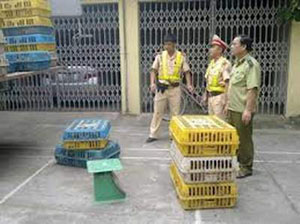Last Updated: Friday, September 21, 2012 08:50:00
|
Local authorities worry that it took just one month to spread from north to central Vietnam, but international experts do not predict a worse scenario than in previous years

This picture taken on March 16 shows slaughtered chickens being displayed for sale at a local market in Hanoi. A new strain of the bird flu virus, which is deadly to humans, has appeared in Vietnam and is spreading rapidly, according to the Department of Animal Health. Photo: AFP
A new strain of the H5N1 virus known as bird flu has appeared in Vietnam, but the Food and Agriculture Organization (FAO) says there is no reason to believe it is any more virulent than previous strains.
“In the past, the occurrence of variations in the virus has resulted in limited upsurges of outbreaks and the FAO expects this situation will be the same,” the UN agency said in a statement to Vietweek.
According to the Vietnamese Department of Animal Health, bird flu outbreaks have been detected in the northern and central provinces of Ha Tinh, Ninh Binh, Nam Dinh, Bac Kan, Quang Ngai, Hoa Binh and Tuyen Quang, where more than 180,000 chickens and ducks have been culled so far.
“There is a new strain of the H5N1 virus that is spreading fast with a high capacity to kill humans,” Diep Kinh Tan, deputy minister of Agriculture and Rural Development, said at a recent meeting of the National Committee for Avian Influenza Disease Control and Prevention.
“The central government is very concerned,” he said.
Prime Minister Nguyen Tan Dung has also instructed relevant agencies nationwide to enforce bird flu control protocols and establish inspection teams to monitor bird flu prevention measures.
The agriculture ministry will coordinate with provinces and cities to detect the presence of H5N1 in poultry early in order to immediately inform health agencies to take preventive measures to limit the number of human infections.
Hoang Van Nam, acting director of the Department of Animal Health, said the new H5N1 strain is “more toxic” than previous ones.
He said the strain belongs to a subclade of the 2.3.2.1 clade that infected poultry in Vietnam in 2011.
“There is a high possibility that this new subclade will spread wider,” he said.
Nguyen Tung, deputy director of the Central Veterinary Diagnosis Center, said the new strain appeared in July and took just one month to spread from north to central Vietnam.
“The center will test existing vaccines against the new strain,” he said.
Smuggled chicks to blame?
Nguyen Thanh Son, deputy director of the Husbandry Department said he suspected that the source of the new strain of infected poultry was chicken smuggled into the country from China.
“The virus spread where the smuggled chicken was being brought to,” he explained.
Deputy minister Tan instructed the Husbandry Department to step up surveillance efforts aimed at preventing newly-hatched chickens from China from entering Vietnam for breeding, which carries far greater risk of spreading the virus than chicken for food.
According to the World Health Organization (WHO), bird flu has been especially deadly in Vietnam, which has recorded at least 61 deaths among 122 infected patients since 2003.
The avian influenza virus has killed 349 people among 594 cases worldwide, and scientists have voiced concern it could mutate into a form readily transmissible between humans, with the potential to kill millions.
Two of the four people within Vietnam to become infected this year have died. The most recent fatality was a man from the Central Highlands province of Dak Lak in March – several months before the new strain was identified.
However, the WHO and the FAO, while calling for preventive measures, both said the presence of the new strain does not mean that major outbreaks are more likely to occur.
The FAO has an on-going program to support the Department of Animal Health to control avian flu and is helping the department identify the new strain.
“It is likely that some but not all available vaccines will protect against this variant,” the organization said. “A vaccine trial has been set up by the Department of Animal Health to test a newly available vaccine against this variant and earlier viruses present in Vietnam.
“Older ducks are resistant to H5N1 disease, whereas young ducks are more susceptible. Therefore, some areas will experience more severe outbreaks depending on the age of the poultry population being raised there.”
According to the WHO, bird flu infections among humans are rare, sporadic and occur mostly in areas where the virus is circulating endemically among poultry.
“There is currently no evidence to suggest that this present strain of the H5N1 virus will have an increased risk to human health,” the UN agency said. http://www.thanhniennews.com/index/pages/20120921-vietnams-new-strain-of-bird-flu-spreading-fast.aspx?




 Zimbabweans are at risk of contracting the deadly Ebola virus which has been reported in the DRC as the country does not have enough trained health personnel to control ports of entry.
Zimbabweans are at risk of contracting the deadly Ebola virus which has been reported in the DRC as the country does not have enough trained health personnel to control ports of entry.




